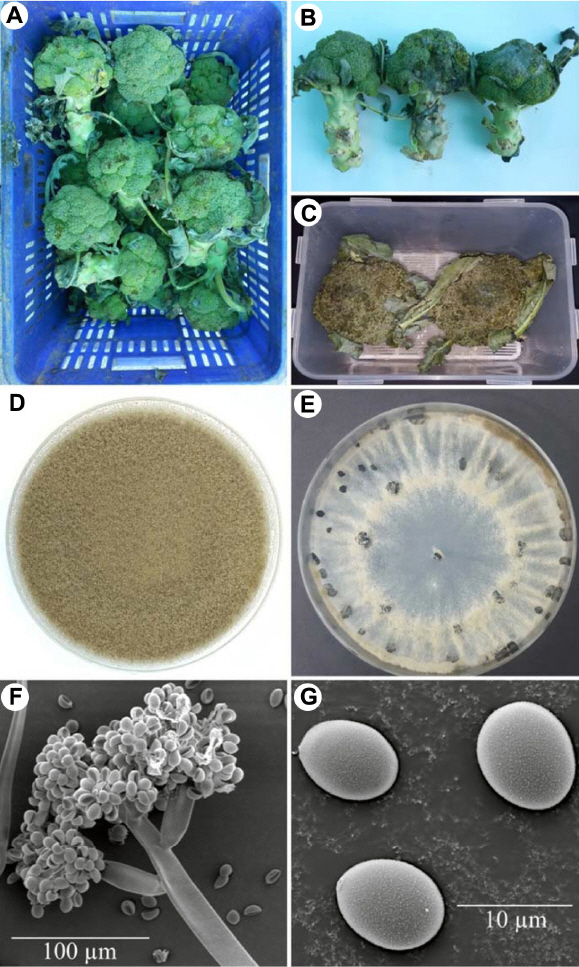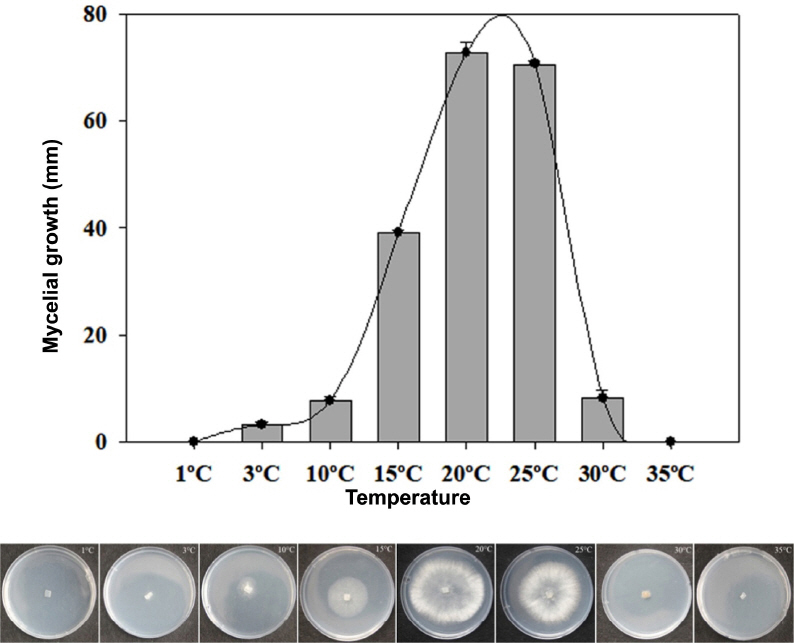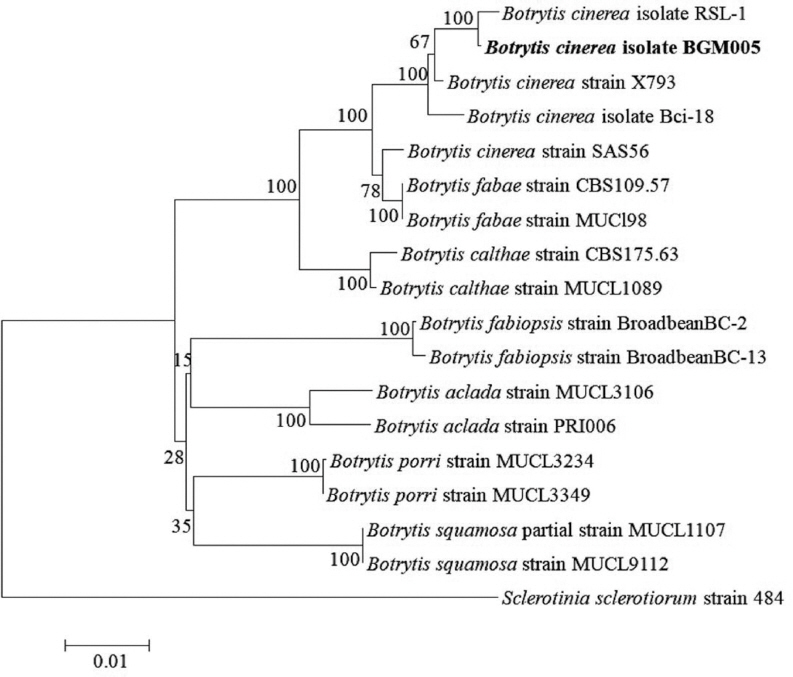Aktaruzzaman, M, Afroz, T, Kim, B. S and Lee, Y. G 2017a. Occurrence of postharvest gray mold rot of sweet cherry due to Botrytis cinerea in Korea.
J. Plant Dis. Prot 124: 93-96.

Aktaruzzaman, M, Lee, Y. G, Afroz, T and Kim, B. S 2017b. The Occurrence of postharvest gray-mold rot of sweet persimmon caused by Botrytis cinerea in Korea.
Eur. J. Plant Pathol doi:10.1007/s10658-017-1254-1. (In press)

Aktaruzzaman, M, Kim, J. Y, Xu, S. J and Kim, B. S 2014. First report of postharvest gray mold rot on carrot caused by Botrytis cinerea in Korea.
Res. Plant Dis 20: 129-131.

Bahadoran, Z, Mirmiran, P and Azizi, F 2013. Potential efficacy of broccoli sprouts as a unique supplement for management of type 2 diabetes and its complications.
J. Med. Food 16: 375-382.


Barnett, H. L and Hunter, B. B 1972. Illustrated genera of imperfect fungi. Burgess Publishing Company, Minneapolis.
Beever, R. E and Weeds, P. L 2007. Taxonomy and genetic variation of Botrytis and Botryotinia. In: In: Botrytis: Biology, Pathology and Control, eds. by Y Elad, B Williamson, P Tudzynski and N Delen, pp. 29-48. Kluwer Academic Publishers, Dordrecht, The Netherlands.

Conaway, C. C, Getachun, S. M, Liebes, L. L, Pusateri, D. J, Tophan, D. K, Botero-Omary, M and Chung, F. L 2000. Disposition of glucosinolates and sulforaphane in humans after ingestion of steamed and fresh broccoli.
Nutr. Cancer 38: 168-178.


Dean, R, van Kan, J. A. L, Pretorius, Z. A, Hammond-Kosack, K. E, Di Pietro, A, Spanu, P. D, Rudd, J. J, Dickman, M, Kahmann, R, Ellis, J and Foster, G. D 2012. The Top 10 fungal pathogens in molecular plant pathology.
Mol. Plant. Pathol 13: 414-430.



Droby, S and Lichter, A 2004. Post-harvest Botrytis infection: etiology, development and management. In: In: Botrytis: Biology, Pathology and Control, eds. by Y Elad, B Williamson, P Tudzynski and N Delen, pp. 349-367. Kluwer Academic Publishers, The Netherlands.

Elad, Y 1997. Effect of filtration of solar light on the production of conidia by field isolates of Botrytis cinerea and on several diseases of greenhouse-grown vegetables.
Crop Prot 16: 635-642.

Ellis, M. B 1971. Dematiaceous Hyphomycetes. Kew. Commonwealth Mycological Institute.
Ellis, M. B and Waller, J. M 1974. Sclerotinia fuckeliana (Conidial State: Botrytis cinerea). CMI Descriptions of Pathogenic Fungi and Bacteria No. 431. England Commonwealth Mycological Institute.
Fernández-León, M. F, Fernández-León, A. M, Lozano, M, Ayuso, M. C and González-Gómez, D 2013. Different postharvest strategies to preserve broccoli quality during storage and shelf life: Controlled atmosphere and 1-MCP.
Food Chem 138: 564-573.


Fillinger, S and Elad, Y 2015. Botrytis - the Fungus, the pathogen and its management in Agricultural Systems. Springer.
Grant-Downton, R. T, Terhem, R. B, Kapralov, M. V, Mehdi, S, Rodriguez-Enriquez, M. J, Gurr, S. J, van Kan, J. A. L and Dewey, F. M 2014. A Novel Botrytis species is associated with a newly emergent foliar disease in cultivated Hemerocallis.
PLoS One 9: e89272



Heber, D, Li, Z, Garcia-loret, M, Wong, A. M, Lee, T. Y, Thames, G, Krak, M, Zhang, Y and Nel, A 2014. Sulforaphane-rich broccoli sprout extract attenuates nasal allergic response to diesel exhaust particles.
Food Func 5: 35-41.

Jarvis, W. R 1980. Taxonomy. In: In: The Biology of Botrytis, eds. by JR Coley-Smith, K Verhoeff and WR Jarvis, pp. 1-18. Academic Press, London.
Kwon, J. H, Cheon, M. G, Choi, O and Kim, J 2011. First report of Botrytis cinerea as a postharvest pathogen of blueberry in Korea.
Microbiology 39: 52-55.

Li, X. P, Kerrigan, J, Chai, W. X and Schnabel, G 2012. Botrytis caroliniana, a new species isolated from blackberry in South Carolina.
Mycologia 104: 650-658.


Lin, C. H and Chang, C. Y 2005. Textural change and antioxidant properties of broccoli under different cooking treatments.
Food Chem 90: 9-15.

Lorenzini, M and Zapparoli, G 2014. An isolate morphologically and phylogenetically distinct from Botrytis cinerea obtained from withered grapes possibly represents a new species of Botrytis.
Plant Path 63: 1326-1335.

Naguib, A, El-M, M, El-Baz, F. K, Salama, Z. A, Hanaa, H. A. E. B, Ali, H. F and Gaafar, A. A 2012. Enhancement of phenolics, flavonoids and glucosinolates of Broccoli (Brassica olaracea, var. Italica) as antioxidants in response to organic and bio-organic fertilizers.
J. Saudi Soc. Agric. Sci 11: 135-142.

Nielsen, K, Yohalem, D. S and Funck, J. D 2002. PCR detection and RFLP differentiation of Botrytis species associated with neck rot of onion.
Plant Dis 86: 682-686.


Romanazzi, G and Feliziani, E 2014. Botrytis cinerea. In: In: Postharvest Decay: Control Strategies, ed. by S Bautista-Baños, pp. 131-146. Elsevier,
Romanazzi, G, Smilanick, J. L, Feliziani, E and Droby, S 2016. Integrated management of postharvest gray mold on fruit crops.
Postharvest. Biol. Technol 113: 69-76.

Saitou, N and Nei, M 1987. The neighbor-joining method: A new method for reconstructing phylogenetic trees.
Mol. Biol. Evol 4: 406-425.

Staats, M, van Baarlen, P, Schouten, A, van Kan, J. A. L and Bakker, F. T 2007. Positive selection in phytotoxic protein-encoding genes of Botrytis species.
Fungal Genet. Biol 44: 52-63.


Staats, M, van Baarlen, P and van Kan, J. A. L 2005. Molecular phylogeny of the plant pathogenic genus Botrytis and the evolution of host specificity.
Mol. Biol. Evol 22: 333-346.


Tamura, K, Stecher, G, Peterson, D, Filipski, A and Kumar, S 2013. MEGA6: Molecular evolutionary genetics analysis version 6.0.
Mol. Biol. Evol 30: 2725-2729.



Tao, Y, Zeng, F, Ho, H, Wei, J, Wu, Y, Yang, L and He, Y 2011. Pythium vexans causing stem rot of Dendrobium in Yunnan Province, China.
J. Phytopathol 159: 255-259.

Toivonen, PM. A and Forney, C 2004. The commercial storage of fruits, vegetables and florist and nursery stock. In: In: USDA, ARS Agriculture Handbook, (66):eds. by KC Gross, CY Wang and M Saltveit, Beltsville, MD.
White, T. J, Bruns, T. D, Lee, S. B and Taylor, J. W 1990. Amplification and direct sequencing of fungal ribosomal RNA genes for phylogenetics. In: In PCR Protocols: A Guide to Methods and Applications, eds. by MA Innis, DH Gelfand, JJ Sninsk and TJ White, pp. 315-322. Academic Press, New York.

Williamson, B, Tudzynski, B, Tudzynski, P and van Kan, JA 2007. Botrytis cinerea: the cause of grey mould disease.
Mol. Plant Pathol 8: 561-680.


Yu, R. H, Gao, J, Wang, J. G and Wang, X 2011. First report of Botrytis leaf blight and fruit rot on Schisandra chinensis caused by Botrytis cinerea in China.
Plant Dis 95: 769

Zhang, Y and Tang, L 2007. Discovery and development of sulforaphane as a cancer chemopreventive phytochemical.
Acta Pharmacol. Sin 28: 1343-1354.


Zhang, Z. Y 2006. Flora Fungorum Sinicorum. 26: Botrytis Ramularia. Science Press, Beijing.
Zhou, Y. J, Zhang, J, Wang, X. D, Yang, L, Jiang, D. H, Li, G. Q, Hsiang, T and Zhuang, W. Y 2014. Morphological and phylogenetic identification of Botrytis sinoviticola, a novel cryptic species causing gray mold disease of table grapes (Vitis vinifera) in China.
Mycologia 106: 43-56.








 PDF Links
PDF Links PubReader
PubReader Full text via DOI
Full text via DOI Download Citation
Download Citation Print
Print






